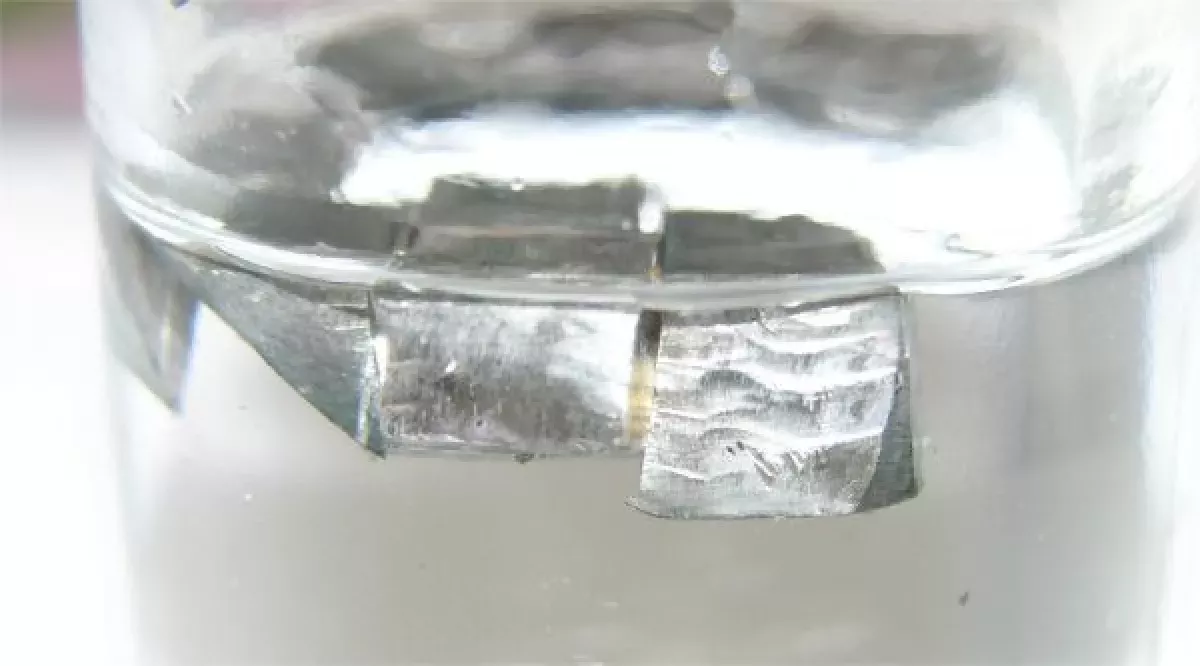Lithium (Li), atomic number 3, is a soft, silvery-white alkali metal. It's the least dense metal and solid element under standard conditions, highly reactive and flammable, requiring storage in inert environments. It tarnishes in air. Lithium isn't found freely in nature but occurs in minerals and brines. It's extracted through electrolysis of lithium chloride and potassium chloride mixtures. Primarily used in batteries, it also has applications in ceramics, lubricants, and polymers.
1923: Commercial Production of Lithium
In 1923, the German company Metallgesellschaft AG initiated the commercial production of lithium through the electrolysis of a liquid mixture of lithium chloride and potassium chloride.
1932: First Human-Made Nuclear Reaction
In 1932, Cockroft and Walton produced the first fully human-made nuclear reaction by bombarding Lithium (Li) with accelerated protons to form Beryllium (Be), which then underwent fission to create two alpha particles. This achievement was referred to as "splitting the atom".
1949: Lithium Reintroduced for Mania Treatment
In 1949, Australian psychiatrist John Cade is credited with reintroducing and popularizing the use of lithium to treat mania.
1963: US Lithium Separation Machinery Shutdown
In 1963, the US shut down most of its machinery used to separate Lithium-6 from Lithium-7, due to a large surplus of separated lithium that had mostly been consumed during the twentieth century.
1979: Soviet Data Collection in Afghanistan
From 1979, the Soviets gathered old data during their occupation of Afghanistan. These data were used in 2010 to estimate the lithium reserves in Afghanistan.
1989: End of Soviet Occupation in Afghanistan
In 1989, the Soviet occupation of Afghanistan ended. Data collected by the Soviets during their occupation was later used in 2010 to estimate the lithium reserves in Afghanistan.
1998: Lithium Metal Price
In 1998, the price of lithium metal was about 95 USD/kg (or US$43/lb).
2007: Lithium-Ion Batteries Dominate Lithium Use
In 2007, the development of lithium-ion batteries significantly increased the demand for lithium, becoming the dominant use. This surge in demand led to the expansion of brine isolation efforts by new companies.
2008: Study on Lithium Carbonate Production
A 2008 study concluded that "realistically achievable lithium carbonate production would be sufficient for only a small fraction of future PHEV and EV global market requirements", that "demand from the portable electronics sector will absorb much of the planned production increases in the next decade", and that "mass production of lithium carbonate is not environmentally sound, it will cause irreparable ecological damage to ecosystems that should be protected and that LiIon propulsion is incompatible with the notion of the 'Green Car'".
2008: Lithium Carbonate Price Drop
After the 2008 financial crisis, major suppliers, such as Sociedad Química y Minera (SQM), dropped lithium carbonate pricing by 20%.
June 2010: Potential Lithium Deposits in Afghanistan
In June 2010, The New York Times reported that American geologists were conducting ground surveys on dry salt lakes in western Afghanistan, believing that large deposits of lithium were located there. The Department of Defense estimated the lithium reserves in Afghanistan to be similar to those in Bolivia, potentially making it the "Saudi-Arabia of lithium".
2010: Chile Leading Lithium Producer
In 2010, Chile was the leading producer of lithium, followed by Argentina. Both countries recovered lithium from brine pools.
2011: Lithium in Aluminium Smelters
In 2011, lithium (as lithium fluoride) was used as an additive to aluminum smelters (Hall–Héroult process), reducing melting temperature and increasing electrical resistance, a use that accounted for 3% of production.
2011: Lithium in Continuous Casting
In 2011, lithium (e.g., as lithium carbonate) was used as an additive to continuous casting mold flux slags, increasing fluidity. This use accounted for 5% of global lithium use. Lithium compounds were also used as additives (fluxes) to foundry sand for iron casting to reduce veining.
2012: Oligopoly in the Lithium Space
A 2012 Business Week article outlined an oligopoly in the lithium space: "SQM, controlled by billionaire Julio Ponce, is the second-largest, followed by Rockwood, which is backed by Henry Kravis's KKR & Co., and Philadelphia-based FMC", with Talison mentioned as the biggest producer.
2012: Projected Increase in Global Lithium Consumption
A 2012 Business Week article projected that global lithium consumption could increase to 300,000 metric tons a year by 2020, from about 150,000 tons in 2012, to match the demand for lithium batteries that had then been growing at about 25% a year.
2012: Geothermal Wells as a Lithium Source
As of 2012, leachates of geothermal wells were identified as another potential source of lithium, where lithium is separated by simple filtration. Reserves are more limited than brine reservoirs and hard rock.
2012: High Grade Ore at Talison Mine
In 2012, the Talison mine in Greenbushes was reported to be the largest and to have the highest grade of ore at 2.4% Li2O.
2013: Lithium-7 Shortage
In 2013, the US Government Accountability Office reported that a shortage of Lithium-7, which is critical for the operation of 65 out of 100 American nuclear reactors, was placing their ability to continue providing electricity at risk.
2015: Lithium Province Identified in the Czech Republic
As of 2015, the Czech Geological Survey considered the Ore Mountains in the Czech Republic as a lithium province. Five deposits were registered, with one near Cínovec considered potentially economical, containing 160,000 tonnes of lithium.
July 2018: Lithium and Uranium Resources Found in Peru
On 16 July 2018, 2.5 million tonnes of high-grade lithium resources and 124 million pounds of uranium resources were found in the Falchani hard rock deposit in the region Puno, Peru.
2018: DRC's Spodumene Deposit
Since 2018, the Democratic Republic of Congo has been known to have the largest lithium spodumene hard-rock deposit in the world, located in Manono.
December 2019: Keliber Oy Reports Lithium Deposit Reserves
In December 2019, Finnish mining company Keliber Oy reported that its Rapasaari lithium deposit had estimated proven and probable ore reserves of 5.280 million tonnes.
2019: World Lithium Production from Spodumene
In 2019, world production of lithium from spodumene was around 80,000 tonnes per annum, mainly from the Greenbushes pegmatite and some Chinese and Chilean sources.
May 2020: Classical Nova Explosions Produce Lithium-7
In May 2020, astronomers reported that classical nova explosions are galactic producers of lithium-7.
2020: Projected Global Lithium Consumption
By 2020, a Business Week article from 2012 projected that global lithium consumption could increase to 300,000 metric tons a year to match demand for lithium batteries.
2020: Australia Grants Major Project Status to Finniss Lithium Project
In 2020, Australia granted Major Project Status (MPS) to the Finniss Lithium Project for a strategically important lithium deposit with an estimated 3.45 million tonnes (Mt) of mineral resource at 1.4 percent lithium oxide.
2020: Lithium Reserves and Production Estimates
In 2020, it was estimated that Chile had the largest lithium reserves (9.2 million tonnes), while Australia had the highest annual production (40,000 tonnes).
2020: Proposal to Extract Lithium from Seawater
In 2020, the use of electrodialysis and electrochemical intercalation was proposed to extract lithium compounds from seawater (which contains lithium at 0.2 parts per million).
January 2021: Protests at Thacker Pass Lithium Mine
Since January 2021, the development of the Thacker Pass lithium mine in Nevada, United States, has met with protests and lawsuits from several indigenous tribes due to concerns about cultural sites and potential risks to indigenous women.
2021: Bolivia's Lithium Production
By 2021, the Bolivian government successfully produced 540 tons of lithium, having invested US$900 million in lithium production by 2022.
2021: Lithium Mining Sources
By early 2021, much of the lithium mined globally came from either spodumene found in hard rock formations or from salty brine pumped directly out of the ground.
2021: Protests Against Lithium Mine in Serbia
During 2021, a series of mass protests broke out in Serbia against the construction of a lithium mine in Western Serbia by the Rio Tinto corporation.
2021: Lithium-Ion Batteries as Primary Use
In 2021, most lithium is used to make lithium-ion batteries for electric cars and mobile devices.
August 2022: Lithium Substance Prices
As of August 2022, the average kilo prices for various lithium substances were stable: Lithium carbonate (99.5% min) between 63 and 72 EUR/kg, lithium hydroxide monohydrate (56.5% min) between 66 and 72 EUR/kg (delivered South Korea – 73 EUR/kg), and lithium metal (99.9% min, delivered China) at 42 EUR/kg.
2022: Half of World's Reserves in Bolivia
As of 2022, half the world's known lithium reserves were located in Bolivia along the central eastern slope of the Andes.
2022: Worldwide Lithium Reserves Estimated
In 2022, the US Geological Survey (USGS) estimated worldwide identified lithium reserves to be 26 million tonnes.
2022: Operational Mining Begins at Finniss Lithium Project
Operational mining began in 2022 at the Finniss Lithium Project in Australia, which had been granted Major Project Status in 2020.
2023: Development Rights Granted for Kolmozerskoye Deposit
In 2023, Polar Lithium, a joint venture between Nornickel and Rosatom, was granted the right to develop the Kolmozerskoye lithium deposit in Russia.
2023: Updated Lithium Reserves Estimate by USGS
In 2023, the US Geological Survey (USGS) updated the worldwide identified lithium reserves estimate to 28 million tonnes.
2023: Excessive Water Extraction by Mining Companies in Argentina
In Argentina's Puna region, in 2023, two mining companies (Minera Exar and Sales de Jujuy) extracted over 3.7 billion liters of fresh water, over 31 times the annual water consumption of the local community of Susques department.
2024: Claim of Cost Savings in Lithium Extraction
In 2024, a redox/electrodialysis system was claimed to offer enormous cost savings, shorter timelines, and less environmental damage than traditional evaporation-based systems for extracting lithium.
2024: Protests Against EU Backed Lithium Mining Project in Serbia
In 2024, an EU backed lithium mining project created large scale protests in Serbia.
2030: Kolmozerskoye Deposit to Reach Full Capacity
By 2030, the Kolmozerskoye lithium deposit project, being developed by Polar Lithium, aims to reach full design capacity, producing 60,000 tonnes of lithium carbonate and hydroxide per year.
Mentioned in this timeline
China officially the People's Republic of China PRC is an...
Australia officially the Commonwealth of Australia encompasses the Australian mainland...
Korea is a peninsular region in East Asia comprised of...
North Carolina is a Southeastern U S state the th-largest...
Argentina officially the Argentine Republic is located in the southern...
South Korea officially the Republic of Korea occupies the southern...
Trending

8 months ago Davante Adams expresses optimism about Rams, refused talks with 49ers over offer.

1 month ago Jakobi Meyers trade: Raiders consider, Steelers and Bills interested, price a factor.
22 days ago AS Monaco's Lineup Against Pafos: Golovin Starts, Fati and Pogba on Bench.

7 months ago Natalee Holloway's disappearance: Joran van der Sloot's Confession Still Raises Questions After 20 Years

7 months ago Jane Fonda Stuns at Cannes Closing with Caged Heels and 3D Florals
1 month ago Drake London Suffers PCL Sprain, Out for at Least One Week.
Popular

Candace Owens is an American conservative political commentator and author...

XXXTentacion born Jahseh Dwayne Ricardo Onfroy was a controversial yet...

Tucker Carlson is an American conservative political commentator known for...

Ilhan Omar is an American politician currently serving as the...

Kashyap Pramod Patel is an American lawyer who became the...

Frederick Christ Trump Sr - was an American real estate...
